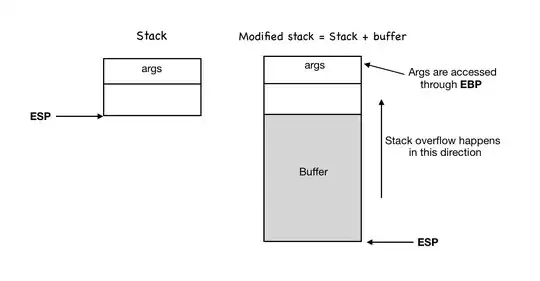Background: Currently trying to exploit a BoF vulnerability. After setting up the environment, running a compiled C program that contains the strcpy function, I disassembled the program as it's running in the Immunity Debugger, so the data at the program's stack during the moment of the crash can be analyzed, and exploited.
Problem: Then according to the researched tutorial videos and blog posts, the next step is to find the offset in the corrupted string that contains the data that is overwritten in the values of ESP and EIP registers. This is done so we can find a JMP ESP instruction in the exe and overwrite the return address (EIP value) using the memory location (w/o bad characters) of the said instruction.
Question: All of the above were done to be under the assumption that the stack pointer (ESP) is pointing at the memory block that contains the payload right after the overwritten and the access violation. So tl dr my question is: How can the ESP be pointing at the payload if it's always supposed to be pointing at the top of the stack?
Visuals, please help explain: Sorry for the smaller size picture. But the picture came from the great Professor Vivek of securitytube.net's SPSE class.

Additionally If someone can please help explain what the ESP value was before and after the crash, and why would the value of ESP be changed to be pointing our payload? is it because of the function creation/death of strcpy, and if it is, how does it play a role in the changed ESP value? The source code is set up like such:
#include <stdio.h>
#include <string.h>
void vuln_func(char* inputstring)
{
char* buf[100];
strcpy(buf, inputstring)
}
int main()
{
// gets input_string
vuln_func(input_string);
return 0;
}
Update: The comment by @gameOver within his answer asked about what the 4141 was in the visual given. Here is a better explanation: 41 is hex for the ascii character of A. Which is what the corrupted string contains. And what the corrupted string contains up to the EIP (returned address) offset is completely arbitrary, in this case was a string of "A", then the return address offset is written with the memory location of JMP ESP, and after that the corrupted string contains the payload to be executed. (Which is where the ESP is pointing at during the crash) Hence my question, why was the ESP pointing at the payload when it was supposed to be pointing at the top of the stack?
